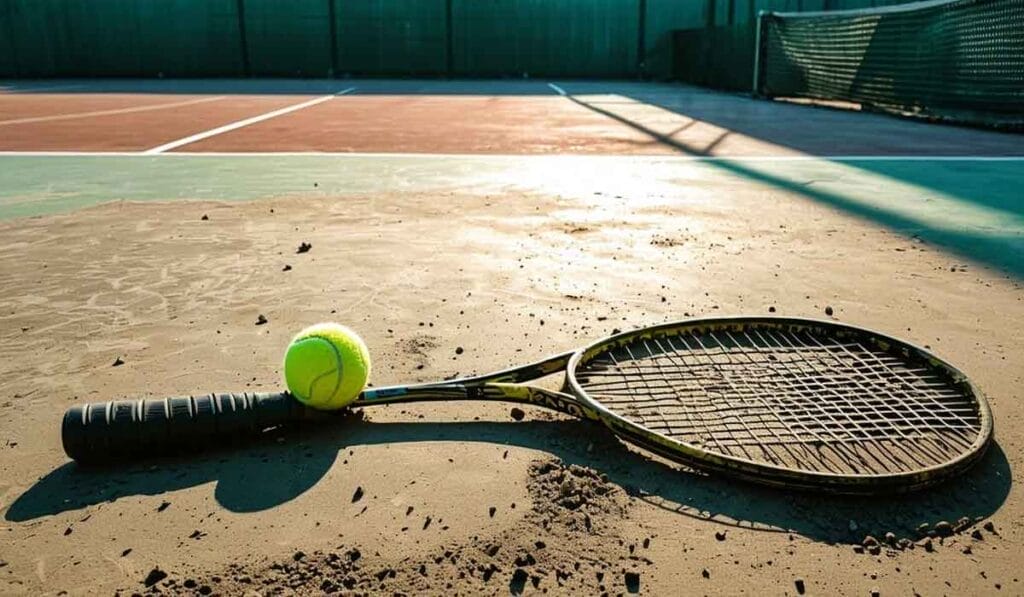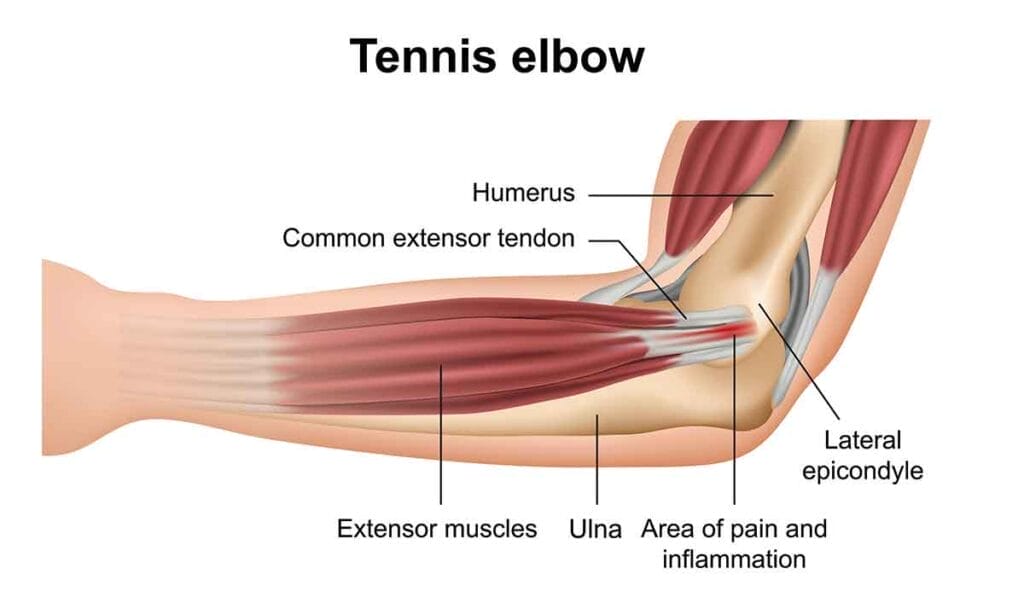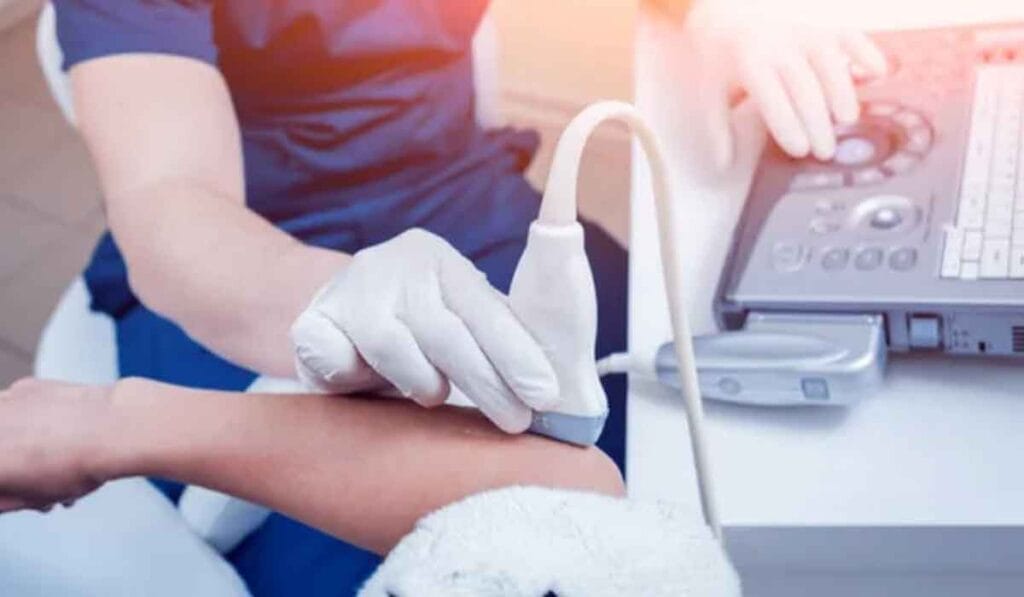Una guía completa para comprender el codo de tenista
¿Te sientes un? Dolor persistente en el parte exterior del codo ¿No se detiene? No está solo. El codo de tenista o epicondilitis lateral, afecta a millones de personas cada año, pero aquí está el truco: es No se limita a los jugadores de tenis..
Esta publicación le guiará a través de ¿Qué lo causa?, Cómo detectarlo, y sí, cómo patearle el trasero. Listo para alivio?
Conclusiones clave
- El codo de tenista puede afectar a cualquier persona, no solo a los deportistas. El uso excesivo debido a movimientos repetitivos de manos y brazos lo provoca.
- Los síntomas incluyen: Dolor o ardor en la parte externa del codo., fuerza de agarre débil y el dolor empeora con ciertos movimientos.
- La mayoría de la gente encuentra Alivio mediante tratamientos no quirúrgicos como descanso, compresas de hielo, medicamentos antiinflamatorios, aparatos ortopédicos, fisioterapia o terapia de ondas de choque.
- Si esos métodos no funcionan, La cirugía puede ser una opciónLas nuevas técnicas a menudo significan tiempos de recuperación más rápidos.
¿Qué es el codo de tenista?

¿El culpable? El uso excesivo de los músculos del antebrazo y movimientos repetitivos de muñeca y brazo que ponen demasiada tensión en la articulación del codo.
Si la vida fuera un juego, el codo de tenista sería su fastidio.
No es una enfermedad exclusiva para deportistas; pintores, carpinteros y personas que manejan teclados pueden unirse al club. El codo de tenista, o epicondilitis lateral si se quiere hablar en términos técnicos, se burla de la idea misma de que “sin dolor no hay ganancia”.
Aquí hay otro truco – No le importa si nunca has cogido una raqueta en tu vida.
Así que la próxima vez que alguien te pregunte por qué haces muecas de dolor al levantar esa taza de café, cuéntale sobre esos malvados músculos del antebrazo actuando nuevamente.
Síntomas del codo de tenista

¿Sientes que te arde el codo cuando levantas una taza de café? O tal vez tu agarre se ha debilitado, lo que hace que te resulte difícil estrechar la mano sin hacer una mueca de dolor. Esos podrían ser signos reveladores de que se está desarrollando el codo de tenista.
Dolor o ardor en la parte externa del codo.
Esta señal grita “codo de tenista” alto y claro, incluso si nunca has usado una raqueta en tu vida.
Este tipo de malestar indica que algo no anda bien con el tendones que conectan los músculos del antebrazo con la parte exterior del codo.
Piense en estos tendones como bandas elásticas.estirarlos demasiado mediante movimientos repetitivos, y comenzarán a protestar en voz alta, con dolor y sensación de ardor.
Ya sea que seas un artista que dibuja constantemente o un entusiasta aficionado al bricolaje que trabaja arduamente, esos movimientos repetitivos de la mano podrían estar causando problemas en la ciudad de los tendones.
Para tratar esta sensación de ardor, es posible que deba darle un descanso al brazo o realizar ejercicios que fortalezcan suavemente esos tendones que protestan.
Su médico podría sugerirle ibuprofeno para reducir la inflamación o recomendarle terapia física para algunos trucos curativos prácticos.
En casos más persistentes, tratamientos como terapia de ondas de choque entran en juego, literalmente, devolviendo a la acción esos tendones cansados sin hacer ninguna incisión.
Así que, aunque el tenis puede estar descartado por ahora, volver a jugar... mañanas sin dolor Definitivamente está a nuestro alcance, con un poco de ayuda de la medicina moderna y algunas medidas inteligentes de su parte.
Fuerza de agarre débil

Tener una agarre débil No se trata solo de tener dificultades para abrir frascos: es un síntoma revelador del codo de tenista. Piénsalo: músculos del antebrazo atar en el codo, y cuando están sobrecargado de trabajo o heridoAferrarse a las cosas se vuelve más difícil.
Se siente como si tus manos se hubieran convertido en las de un personaje de dibujos animados. resbalándose y deslizándose en los peores momentos, como intentar sujetar una raqueta durante un juego intenso o evitar que tu café se caiga de la mesa.
Un agarre fuerte es más que músculo: se trata de conexiones saludables desde las puntas de los dedos hasta el codo.
De cara al futuro, considere cómo este debilitamiento puede realmente sacarlo de su juego, o Vida diaria para el caso.
De repente, las tareas simples parecen esfuerzos hercúleos.
Dolor que empeora con ciertos movimientos.

Coges tu taza de café de la mañana y, ¡ay!, el... parte exterior del codo Gritos. No se trata de un grito cualquiera, sino de una señal reveladora de que el codo de tenista se manifiesta con ciertos movimientos.
Ahora, imagina que estás estrechando manos o girando el pomo de una puerta y sientes ese dolor agudo de nuevo. Parece como si alguien estuviera jugando al ping-pong con tus nervios.
Aquí está el resumen: Actividades que aprietan los músculos del antebrazo o torciendo la muñeca No son solo tareas; son Posibles desencadenantes del dolor.
Piense en deportes de raqueta, jardinería o incluso escribir a máquina durante demasiado tiempo: estos no son los mejores amigos de su brazo si el codo de tenista se ha extendido.
Tu agarre puede pasar de férreo a débil sin previo aviso, haciendo que sujetar cosas parezca una tarea hercúlea.
Así que la próxima vez que te estremezcas mientras... Levantando comestibles o sientes ese ardor después de enviar un revés épico Al otro lado de la cancha, debes saber que es tu cuerpo el que te está indicando que debes tomarlo con calma y tal vez darles algo de qué hablar a esos cirujanos ortopédicos.
Causas del codo de tenista

Entonces, ¿qué hace que el codo de tenista aparezca? No se trata solo de golpear la raqueta con demasiada fuerza o con demasiada frecuencia. Los verdaderos culpables son los movimientos repetitivos (como pintar una obra maestra golpe a golpe o enroscar una bombilla una y otra vez) que tensionan las articulaciones del codo día tras día.
Piensa en ello como si los músculos de tu antebrazo estuvieran enfadados porque están cansados de hacer siempre lo mismo. Y cuando empiezan a protestar, vaya, lo sientes.
¿Desea profundizar más en este tema? ¡Siga leyendo y descubra cómo puede tratar con indiferencia el codo de tenista!
Uso excesivo de los músculos del antebrazo
Hacer girar una raqueta, girar un destornillador o incluso pintar una obra maestra: todas estas acciones parecen bastante sencillas, pero ¿las repites una y otra vez? Los músculos del antebrazo empiezan a sentirse como si hubieran corrido una maratón sin ningún entrenamiento.
Así es, el movimiento repetitivo es someter a tus brazos a una sesión de entrenamiento invisible cada vez. Y no se trata solo de los grandes movimientos; incluso hacer clic con el mouse o escribir en el teclado cuenta.
Bienvenido al club si alguna vez has sentido que tu brazo gritaba pidiendo piedad después de un largo día de lo que parecía no ser gran cosa.
En el antebrazo hay músculos muy activos que intervienen en el agarre firme de objetos, ya sea para sostener la taza de café de la mañana o para darle la mano a alguien con seriedad.
Ahora imagina que tienes que hacer trabajar a esos músculos horas extra sin descansos adecuados. Lo que sucede a continuación no es sorprendente: se inflaman y se ponen irritables, y envían señales de dolor directamente al codo y más allá.
Esto es Codo de tenista apareciendo sin invitación, llamando a tu puerta porque has estado usando demasiado a esos héroes del antebrazo sin darles mucho amor a cambio.
Y no, no se limita a personas que practican su revés en la cancha de tenis; este invitado hace visitas domiciliarias a pintores, carpinteros, chefs y sí, incluso a guerreros de oficina que viven con “ctrl+C” y “ctrl+V”.
Es como organizar una fiesta donde todos están invitados pero se olvida mencionar que es BYOR (trae tu propio descanso).
Ignorar la respuesta puede llevarnos a un camino lleno de compresas de hielo, analgésicos como acetaminofeno o ibuprofeno (piense en Advil o Motrin IB), sesiones de fisioterapia con profesionales que saben cómo mostrarle a los músculos distendidos un poco de cariño... o en casos difíciles, hola visitas al médico para intervenciones más avanzadas como inyecciones de plasma rico en plaquetas o terapia de ultrasonido que susurran prometiendo alivio de este visitante no deseado.
Movimientos repetitivos de muñeca y brazo.

Así como trabajar demasiado los músculos del antebrazo puede llevarte al dolor, hacer lo mismo una y otra vez con la muñeca y el brazo tampoco te hará ningún favor.
Piense en escribir todo el día o tal vez blandir una raqueta de tenis: estas acciones pueden parecer inofensivas, pero pueden estresa tu codo A lo grande.
Es como Tocando la misma nota en un piano sin parar;Al final, algo tiene que ceder.
Ahora, imagínese esto: cada clic del ratón, cada giro del destornillador, se suma. ¡Sus tendones están haciendo horas extras sin paga extra!
Aquí es donde entran en juego cosas como extensor radial corto del carpo entran en juego: ese músculo juega un papel protagónico en movimientos que doblan la mano hacia atrás a la altura de la muñeca.
Y si siempre se mueve a toda velocidad, Las lágrimas comienzan a aparecer más rápido que las palomitas de maíz. en la noche de cine. Eso es lo que te atrapa en la red pegajosa de tendinitis—o como lo conocemos cariñosamente (o no tanto), codo de tenista.
Actividades que tensionan la articulación del codo
Jugar al tenis o al golf puede parecer un día divertido hasta que el codo empieza a gritar: "Oye, ¿y yo qué?". Estos deportes son famosos por poner mucha tensión en las articulaciones del codo.
Pero no son solo los deportistas los que deben tener cuidado. Incluso si eres más un guerrero del teclado o un artista, movimientos repetitivos—Piense en escribir en su computadora o en pintar con un pincel—también puede estresar sus codos más de lo que imagina.
Levantar objetos pesados de forma incorrecta es otro culpable común. Es posible que tu codo no esté contento si te concentras en mostrar esos músculos sin la forma adecuada. Y bueno, incluso algunos quehaceres de la casa, como barrer o hacer jardinería, pueden hacer que los codos trabajen horas extras.
Ahora que hemos hablado de los codos y las actividades que los provocan, veamos cómo los médicos determinan si realmente tienes codo de tenista.
Diagnóstico del codo de tenista

Entonces, ¿cree que tiene codo de tenista? En primer lugar, un médico le examinará bien el brazo y le preguntará qué actividades realiza. Es posible que incluso le pida que mueva el brazo de determinadas maneras.
Pero, a veces, eso no es suficiente para saberlo con seguridad. Y aquí es donde se pone interesante: pueden usar herramientas especiales para tomar fotografías, como rayos X o una máquina de resonancia magnética, para ver más de cerca el interior del codo.
Estas no son simplemente imágenes cualquiera; son súper detalladas y pueden mostrar si algo no está bien con los tendones alrededor del codo.
¿Qué tal las pruebas de diagnóstico por imagen que mencionamos? Bueno, las radiografías son excelentes para examinar los huesos, pero las resonancias magnéticas van un paso más allá al permitir que los médicos vean los tejidos blandos, como los tendones y los músculos, los sospechosos habituales en los problemas de codo de tenista.
¡Ah! Y no nos olvidemos de otra herramienta genial: la ecografía. Este aparato utiliza ondas sonoras (¡sí, ondas sonoras!) para crear imágenes de lo que sucede dentro de tu cuerpo.
Examen físico
El médico revisará el codo para ver cómo se mueve y dónde le duele. Le pedirá que flexione el brazo, gire la palma hacia arriba y hacia abajo y es posible que presione la zona alrededor del codo para determinar dónde siente más molestias.
Piense en ello como un detective que busca pistas, pero en lugar de una lupa, tiene años de entrenamiento de su lado.
Durante este examen, se buscan signos de codo de tenista: Sensibilidad en la parte externa del codo., hinchazón o una disminución de la fuerza de agarreEs como intentar averiguar por qué tu auto no arranca: un buen punto de partida es mirar debajo del capó.
Su médico también podría examinar otras partes de su brazo u hombro para asegurarse de que no haya otro villano detrás de su dolor.
Después de examinarlo de cerca, los profesionales de la salud a menudo sugieren: pruebas de imagen Si creen que hay más en la historia, por ejemplo: radiografías o una resonancia magnética – herramientas que permiten a los médicos echar un vistazo al interior sin tener que hacer ningún corte.
De esta manera, pueden descartar problemas como fracturas o artritis que afecten a su articulación. ¿El siguiente paso? Descubrir cuál es la mejor manera de deshacerse de ese molesto codo de tenista.
Pruebas de imagen cuando sea necesario
Los médicos podrían ordenar pruebas de imagen Si no pueden averiguar qué está pasando con su codo con solo mirarlo y palparlo, estos incluyen ecografías, que son como ventanas secretas en tu brazo, que muestran tendones y músculos en acción en vivo.
Otra herramienta en su cinturón es exploraciones de resonancia magnéticaSon los peces gordos, que proporcionan imágenes detalladas de huesos y tejidos blandos, permitiendo a los médicos echar un vistazo al interior sin hacer un solo corte.
Los radiólogos desempeñan un papel muy importante en este caso, ya que actúan como detectives con estas herramientas. Imagínese que utilizan energía ultrasónica o técnicas artroscópicas para buscar pequeñas pistas sobre su codo de tenista.
No es algo que ocurre todos los días: solo recurren a estas técnicas cuando las comprobaciones habituales no resuelven el misterio.
Una imagen vale más que mil palabras, especialmente para diagnosticar casos complicados de codo de tenista.
Opciones de tratamiento para el codo de tenista
Si el codo le ha estado molestando debido al codo de tenista, ¡no se preocupe! Hay muchas maneras de aliviarlo. En primer lugar, la mayoría de las personas encuentran alivio sin necesidad de cirugía. Considere aplicar hielo en el punto dolorido o tomarse un descanso de las actividades que le provocan dolor.
Su médico podría sugerirle usar un aparato ortopédico o hacer ejercicios especiales para fortalecer sus músculos.
Pero si estos pasos no son suficientes, existen métodos más avanzados, como la terapia con ondas de choque o la aplicación de una inyección con factores curativos directamente en el codo. Y, para aquellos casos excepcionales en los que nada más funciona, la cirugía podría ser la solución.
Ya sea un pequeño corte o el uso de pequeñas cámaras para arreglar cosas en el interior, la tecnología actual significa que la recuperación es más rápida que nunca.
Entonces, no importa cuán persistente sea tu codo de tenista, tienes opciones.
Tratamientos no quirúrgicos

Tienes codo de tenista y estás buscando formas de solucionarlo sin pasar por el quirófano. Por suerte, existen muchas opciones para ayudarte a curar el codo y volver a ser tú mismo.
- El descanso es tu primer amigo En la batalla contra el codo de tenista, dale un descanso a tu brazo de aquellas actividades que hacen que el dolor se haga notar.
- Aplicación de compresas de hielo Puede aliviar esa sensación de ardor en la parte exterior del codo, reduciendo la hinchazón como por arte de magia.
- Medicamentos antiinflamatorios, como el ibuprofeno o el naproxeno, pueden aliviar el dolor y la hinchazón. Recuerde que Aleve es otro nombre que debe recordar.
- Un soporte o correa envuelve Hacer ejercicios alrededor del antebrazo puede parecer simple, pero funciona de maravillas al aliviar la presión sobre los músculos.
- Terapia física entra en juego con ejercicios que estiran y fortalecen los músculos del antebrazo sin enojarlos.
- Ajustes en la terapia ocupacional Cómo realizar tareas cotidianas para evitar movimientos que te pinchen el codo de tenista con un palo.
- Terapia de ondas de choque extracorpóreas Suena a ciencia ficción, pero se trata de enviar ondas sonoras para despertar el proceso de curación del codo.
- Inyecciones de corticosteroides Cerca del punto dolorido puede brindar alivio más rápido de lo que usted puede decir "ouch", pero no exagere, ya que demasiado podría no ser algo bueno.
- Plasma rico en plaquetas La terapia (PRP) utiliza algunas de las plaquetas de su sangre para reunir a las tropas y reparar los tendones lesionados.
- La terapia de puntos gatillo se pone a cero en puntos doloridos específicos, convenciéndolos de relajarse con una combinación de técnicas de presión y liberación.
Estas vías ofrecen esperanza más allá de la cirugía, apuntando a una vida libre de molestias en el codo mientras se mantienen las cosas simples y no invasivas, porque ¿quién quiere realmente una operación cuando potencialmente podría resolverlo sin una?
Tratamientos quirúrgicos cuando sea necesario
Si esas estrategias no invasivas no dan resultado y su codo de tenista sigue jugando duro, tal vez sea momento de hablar sobre intentar atacarlo. Opciones quirúrgicasPiénsalo de esta manera: a veces, el cuerpo necesita un poco de ayuda adicional de la medicina moderna para volver a funcionar.
La cirugía no es el primer paso, sino más bien un plan B cuando todo lo demás no ha aliviado ese molesto dolor en el codo.
Los médicos tienen algunos trucos ingeniosos bajo la manga para los casos persistentes de codo de tenista. Podrían sugerir procedimientos mínimamente invasivos que suenan como si fueran sacados de una película de ciencia ficción, como cirugía artroscópica o tenotomía ultrasónica.
La artroscopia utiliza pequeñas cámaras e instrumentos a través de pequeñas incisiones para solucionar el problema sin abrir demasiado el brazo. Imagine arreglar un reloj con pinzas en lugar de desarmarlo por completo: eso es lo que los médicos buscan aquí.
Para algo aún menos invasivo, existe fenestración de aguja donde los médicos usan agujas para hacer pequeños agujeros en el tendón, fomentando la curación sin necesidad de una cirugía mayor.
O ultrasonidos Puede descomponer el tejido dañado con vibraciones de alta frecuencia en la tenotomía ultrasónica: ¡un enfoque verdaderamente futurista! Estos métodos significan tiempos de recuperación más cortos y hacer que te pongas de pie nuevamente, y tal vez incluso puedas blandir esa raqueta, más temprano que tarde.
Además, son una prueba de que a veces la ciencia ficción se convierte en ciencia ficción cuando se trata de curar nuestros cuerpos.
Conclusión

Entonces, ya tienes todo lo que necesitas saber sobre el codo de tenista. Desde por qué sucede hasta todos esos... Gimnasia repetitiva de manos y brazos – a cómo se siente (¡ay!), y sin olvidar el Maneras de decir adiós al dolor.
Ya sea que esté pensando en darle a su antebrazo un merecido descanso o esté considerando hablar con el médico para obtener opciones más resistentes, piense: no se trata solo de usando aparatos geniales o mostrar cicatrices.
Se trata de Volviendo al juego, sin dolor. Así que, ¡pónganse esa determinación como si fuera una venda! Y, si la cirugía les parece más aterradora que enfrentarse a Serena Williams en la cancha, quédense tranquilos sabiendo que la mayoría de la gente encuentra Alivio sin pasar por el quirófano.
Comentarios adicionales del Dr. Nguyen sobre el codo de tenista
En el caso del codo de tenista o de golfista, he llegado a la conclusión de que si la lesión no se cura por sí sola después de 3 meses, nunca se curará sin manipular el sistema inmunológico.
Ninguna cantidad de ejercicio funciona.
Lo que sí funciona es la punción seca y, más potente, la tercera generación. PRF con gel de albúmina.
A casi todos los dolores se les ha solucionado después de 2 o 3 inyecciones del PRF.
preguntas frecuentes
1. ¿Qué es exactamente el codo de tenista y cuáles son sus síntomas?
El codo de tenista, también conocido como epicondilitis lateral, es un tipo de tendinitis que provoca dolor en los músculos del antebrazo cerca del codo. Los síntomas suelen incluir molestias alrededor del hueso del brazo y los dedos.
2. ¿Puede hablarme de algunos factores de riesgo del codo de tenista?
¡Por supuesto! El codo de tenista puede ser causado por movimientos repetitivos del brazo o cambios artríticos en las articulaciones. No es algo que solo les ocurre a los deportistas: cualquiera puede sufrirlo si hace demasiado uso de las palmas de las manos.
3. ¿Cómo diagnostican los médicos esta condición?
El diagnóstico generalmente implica un examen físico realizado por médicos de atención primaria o especialistas en ortopedia en un centro médico, pero también puede utilizarse la electromiografía (EMG) para confirmarlo.
4. ¿Qué opciones de tratamiento están disponibles para el codo de tenista?
Hay varias formas de tratar el codo de tenista, desde medicamentos antiinflamatorios no esteroides (AINE), inyecciones de esteroides, proloterapia hasta fisioterapia guiada por terapeutas capacitados.
5.¿Qué pasa si estos tratamientos no funcionan?
Si todo lo demás falla, ¡siempre existe la opción de la cirugía! Las cirugías para el codo de tenista, como la cirugía abierta o el uso de un artroscopio, pueden considerarse según la gravedad de su caso.
6.¿Existen otras condiciones similares que debería conocer?
¡Sí, por supuesto! La epicondilitis medial, conocida comúnmente como codo de golfista, es otra forma común de lesión de tendón que afecta distintas partes del antebrazo.

